Moonta Mines



Discover Stangate Garden, one of the Adelaide Hills secret treasures. Pack a picnic and spend the day enjoying the tranquil garden setting.
Stangate Garden was designed by Elsie Cornish, a renowned garden designer with a unique sense of colour and composition. Home to one of Australia’s largest oak trees where people have picnicked for more than a hundred years, the gardens were also recognised by the International Camellia Society in 2012 as an International Camellia Garden of Excellence. While the camellias are in full bloom in early spring, the garden offers something magical all year round.
Cost: $8 Adults, FREE for National Trust members and for children under 15. Group (max 4) $20. Pre-booking is not required. Payment accepted at the gate on the day.
Enquiries: bookings@nationaltrustsa.org.au or 8202 9200 or visit www.nationaltrust.org.au/places/stangate-house-and-garden/
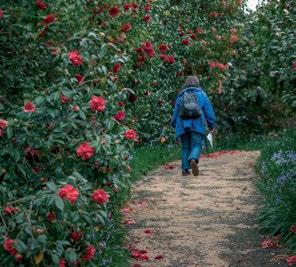

Stangate House and Garden, 3 Edgeware Road, Aldgate



In this issue of Heritage Living you will find a range of articles that illustrate the many and varied areas where the National Trust has sought to fulfil its statutory role and responsibility as a body with the object of preserving and maintaining for the benefit of the people of South Australia lands and buildings of beauty or historic, scientific, artistic, or architectural interest and, as regards lands, the preservation (so far as practicable) of their natural aspect features and animal and plant life. We also have responsibility for the protection and augmentation of the amenities of such lands and buildings and their surroundings, the preservation of furniture and pictures and chattels of national, historic, artistic, or scientific interest and we should facilitate the access to and enjoyment of such lands, buildings, and chattels by the public.

While the Trust’s primary responsibility is to meet these obligations in relation to land and buildings which the Trust either owns or has the custodianship of, at various times in the Trust’s history it has also advocated for the retention of heritage places under threat of demolition and for changes to law and policy which impact upon heritage. The Trust sees the heritage advocacy role as an important one.
Readers will be familiar with the Trust’s recent and very public campaigns in relation to Ayers House, Martindale Hall and the Waite Gatehouse. The State Government’s recent decision to remove the State Heritage listing of the Thebarton Police Barracks to enable them to be demolished to make way for a new Women’s and Children’s Hospital is most concerning. The government’s stealth-like actions saw it publicly announce the proposal and then in a matter of weeks rapidly push through State Parliament, legislation to summarily remove the Barracks State Heritage listing. There was no public consultation on the proposed legislation nor any other opportunity for relevant and interested community groups to express an opinion on that proposal.

The removal of the State Heritage listing status of the Thebarton Police Barracks complex and the manner by which it was undertaken is a very low point in the history of heritage treatment and recognition in South Australia. The National Trust has written to the Environment and Heritage Minister, Dr Susan Close, urging immediate action to implement a much more rigorous legislative and policy system to improve protection of all heritage places. Any proposal to demolish a State heritage place must be the subject of a public report by the SA Heritage Council and open to full public consultation. Demolition of State heritage places should always be actively discouraged and subject to Parliamentary review.
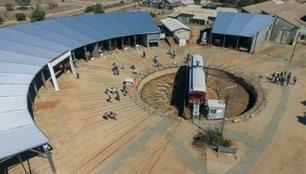
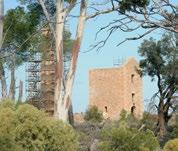
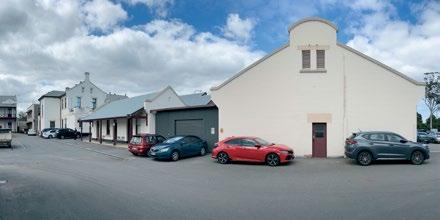
The election of the Malinauskas Government in 2022 was welcomed by many on the basis of commitments made to better protect South Australia’s heritage and to review new planning rules that adversely impact our historic places, trees and open space.
For the National Trust, one of the most important commitments made by the then Opposition was to legislate an Ayers House Act placing ongoing care, control and management of Ayers House with the National Trust. Other commitments made were to work with the community and the Trust to develop a shared plan for the future of Martindale Hall in the Clare Valley and to improve the protection of Aboriginal heritage. Almost a year after the election some of those commitments are proceeding, but many are now lagging.
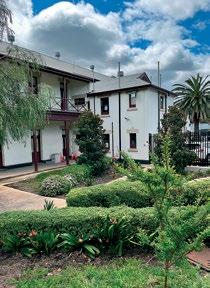
Regrettably, one of the new government’s early decisions with respect to the Thebarton Police Barracks has raised many concerns about its commitment to the future of established heritage protections. The removal of the State Heritage listing status of the Thebarton Police Barracks complex and the manner by which it was undertaken is a very low point in the history of heritage treatment and recognition in South Australia.
Listing of something as a State Heritage Place under South Australian law has, until now, been seen as giving the place permanent protection against demolition or radical reconstruction. The Government’s actions in putting forward the New Women’s and Children’s Hospital Bill 2022 has fundamentally altered that perception. It would seem that the listing of a place as a State Heritage Place does not necessarily protect that place any longer, particularly if it is the State government who owns the Place.
The Government’s cavalier disregard of its own statutory heritage protection scheme makes the National Trust extremely concerned about the future of the heritage protection system in South Australia and the undesirable precedent set by this decision. We call on the Government to redress the perception it has created of further weakening heritage protections and to take immediate action to ensure that there is a much more rigorous legislative and policy system put in place to improve protection of all heritage places.

We welcome the new Government initiating an implementation review of the State’s planning system introduced in 2021, but note the circumscribed scope of the current review. The public discussion papers for the review limit the matters for consideration and exclude major issues from debate such as public access to information and community participation in decision making.
It is worth noting that early in the decade long planning “reform” process another Expert Panel on Planning, in 2014, made nine recommendations with respect to the treatment of heritage within the planning system. In the eight years since, none of those recommendations have been implemented.
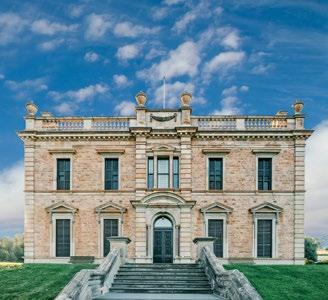
South Australia’s planning policy makers continue to treat heritage as a problem rather than an opportunity. As a result, our planning laws and rules do less to protect our heritage than those in other states. South Australia was once a leader in this area; it has now fallen well behind.
In the context of the current planning review the State Planning Commission has signaled a desire to address a few of the failures of the new Planning and Design Code with respect to protecting trees in the urban environment and possibly to address some of the damage done to heritage protections, particularly in relation to local heritage places in our historic suburbs and towns. Stronger demolition controls for historic buildings may be recommended after those protections were weakened in the Planning and Design Code.
We will have to see what positive directions come from the review when it reports mid-year and hope that any proposed improvements are implemented quickly.
As members are well aware, the Trust was evicted from Ayers House by the former Liberal Government in 2021, forced to close the Ayers House Museum to the public and completely vacate the site by February 2022, after fifty years as the primary custodian of the building and almost seventy years of advocating for its preservation.
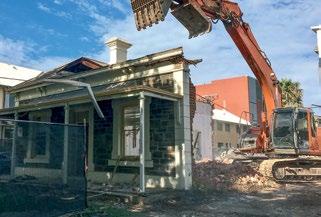

The public outrage over the treatment of the National Trust and the threatened repurposing of Ayers House as government offices and catering facilities spurred 20,000 people to sign our petitions to Parliament in advance of the election. All of those people welcomed the commitments made by Labor and supported by cross bench SA Best and SA Greens MPs in the leadup to the election. We look forward to early passage of the Ayers House legislation.
Above: Ayers House campaign supporters.
Right: Sad signage at Ayers House as it sits empty after the Trust was evicted.

The former Liberal Government broke its pre-election commitment not to privatise Martindale Hall when it passed legislation to remove its status as a conservation park and the charitable trust covering the property. Fortunately, that legislation failed to pass the Upper House and Martindale Hall was once again kept for the public and saved from an uncertain future in private hands. We welcome the new government’s commitment to work with the Trust to create a vibrant heritage destination for the benefit of all South Australians.
Unique in Australia for its three-gauge turntable, the Peterborough Roundhouse has undergone important restoration work as part of a multi-million dollar heritage tourism project led by the National Trust. The roundhouse will celebrate its centenary in 2024, making these works a timely gift to the local community.
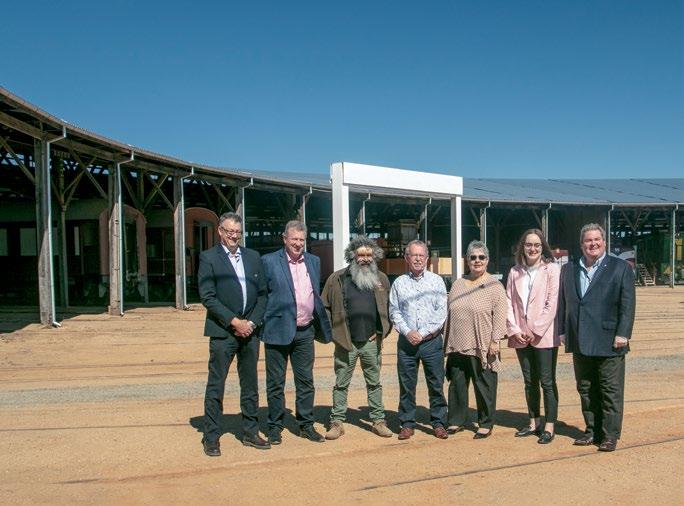

The Silver to Sea Way is a regional economic revitalisation initiative which follows the old narrow-gauge rail line from Silverton in New South Wales to Port Pirie in South Australia. Encompassing the route between Port Pirie and Peterborough, Stage 1 is well underway with funding from the Federal Government’s Building Better Regions Fund.
Several sites of interest lie along the Stage 1 route, including the Peterborough Roundhouse where an exciting series of regeneration works has already been successfully completed. The works comprised a range of recification and restoration activities including replacing the entire roof of this massive structure.
The Silver to Sea Way team and the District Council of Peterborough celebrated these achievements by co-hosting an Open Day. This was the first time that visitors were allowed on site since works began. The event and its two free site tours were well attended, with visitors guided around the restored roundhouse by Shirley Edmonds, a volunteer with Peterborough’s Steamtown Heritage Rail Centre. Visitors marvelled at the new columns and beams, fashioned by McMahon Services from timber donated by the City of Mount Gambier Council recycled from the demolished Mt Gambier Roundhouse. Likewise, the sleek custom-made steel collars used to reinforce the structural integrity of various joints impressed many. To properly recognise the achievements of all those involved in the regeneration works, Open Day attendees were invited to gather in the Diesel Shed where Quenten Agius, Chair of the Ngadjuri Nation Aboriginal Corporation, welcomed them to country. Following this welcome, State MP (Stuart) and Minister for Local Government, Geoff Brock spoke of the importance of the Silver to Sea Way project for the local region. Peterborough’s Mayor Ruth Whittle also commended the project for helping to future-proof the local visitor economy. Finally, National Trust President Paul Leadbeter thanked the local community for its ongoing support.
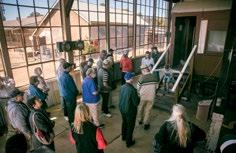

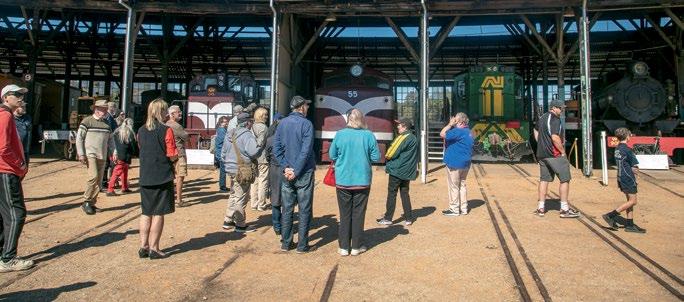
Although we look forward to remaining engaged with the Peterborough community through other aspects of the project, we have now turned our attention to Port Pirie, with works set to begin at the Port Pirie Railway Station and Customs House. Meanwhile, work is also being undertaken on a variety of other activities across the region, including community skill-building workshops and the ‘Places in Cases’ school program.
For updates on the Silver to Sea Way project, visit www.s2sw.com.au where you can subscribe to our project newsletter & follow the links to Facebook and Instagram.

Supported by

Below:
An innovative concept developed by the National Trust is inspiring school children to engage with local history as part of the Silver to Sea Way initiative, but what exactly are Places in Cases?
APlace in a Case is a museum display created in an old travelling case. Part doll’s house, part diorama, the display is made in response to an historic image.
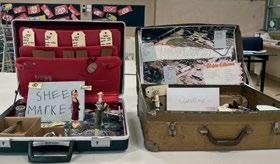
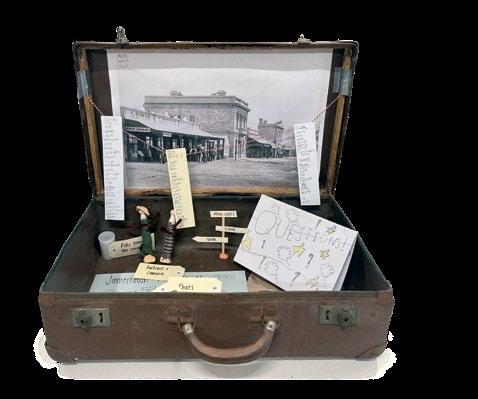
At Jamestown Community School, for example, Years 5 and 6 students were divided into small groups. Gathered around tables, they surveyed empty vintage travelling cases, a selection of old photos provided by the Jamestown branch of the National Trust, and a wide range of items such as pipe cleaners, coloured papers and pencils, empty lidded jars and containers, string, wire, wool, fabric, ribbon, and plasticine. Each group selected an historic image. They were then encouraged to ‘squeeze’ the photo. Squeezing a photo is basically an exercise in questioning: What can you see? If you were in this photo, what would you be able to smell? What would you be able to hear? What could you feel, both physically and emotionally? The answers were
The students then turned their attention to the craft materials in front of them. This time they were challenged to respond to the questions by crafting a creative piece for display in the case. A large number of bikes in an image might prompt a student to craft a bike bell from a pipe cleaner. A horse-drawn tram might lead to an empty jar being labelled ‘horse manure’. Another student might mould a plasticene model of a hat someone is wearing.
To create the mini museum, the historic image inspiring the display is fixed to the underside of the suitcase lid so the photograph is revealed when the case is opened. The objects created by the students are placed
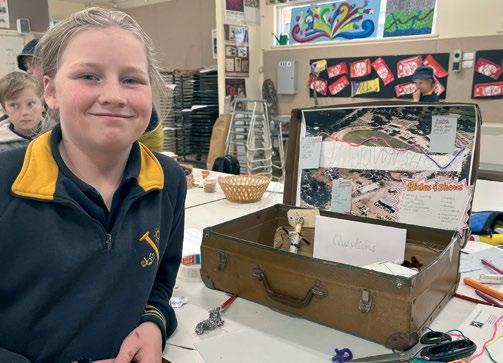
The Places in Cases concept introduces students to local history in a way that is challenging, thought provoking and creative, by prompting them to seek out questions, rather than answers, in the first instance.
It connects them with local history in a way that is meaningful to them, developing skills they can use throughout their lives – observation, speculation, imagination, empathy and
Once created, the mini museums can then be shared, providing a novel and interactive way to introduce both the local community and visitors to the heritage of a place.
Human-induced climate change is one of the most difficult challenges ever faced by our species. The Intergovernmental Panel on Climate Change recently found that we need to cut emissions in half by 2030 and reach net zero by 2050 if we are to keep global warming within 1.5 degrees Celsius.
The construction industry is one of the greatest producers of emissions in its use of vast amounts of energy and resources. Globally, it accounts for more cement use than any other sector, 26 per cent of aluminium output, 50 per cent of steel production and 25 per cent of plastic use. It is also responsible for 39 per cent of global carbon emissions. For this reason, the Architects’ Journal in the United Kingdom has launched a RetroFirst campaign. Backed by thirteen winners of the UK’s most prestigious architectural awards (the RIBA Stirling Prize), the campaign ‘proposes a major reduction in the consumption of raw materials and energy in the built environment through the adoption of circular economy principles. It opposes unnecessary and wasteful demolition of buildings and promotes low-carbon retrofit as the default option.’
An oft-used argument against adaptive re-use is that new builds are more energy efficient. This argument fails to take into account the difference between the day-to-day energy consumption of a building and its overall life-cycle impact. According to a study in the Journal of Architectural Conservation, when existing buildings are upgraded to the same energy standards as new builds, their overall life-cycle impact is significantly lower. Furthermore, retrofitting existing buildings is more economical as it requires fewer materials and a shorter construction time.
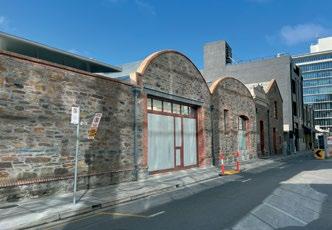
There are many examples of buildings that have been successfully adapted for new uses in Adelaide. One example is the Darling Building on Franklin Street, built in 1916 by prominent architect E.H. McMichael in a Classical Palazzo style. The building had fallen into a state of disrepair but was renovated and restored in 2015 by architects Williams Burton Leopardi and now used as an office building. Another example is the former Adelaide Brewery Building in Wyatt Street: it too has been converted into offices.
In Australia, arguments in favour of adaptive re-use usually focus on the heritage value of the building. However, the environmental benefits of retaining existing buildings provide an even more compelling case for it. The preservation of our built heritage can also be an effective form of climate action, reducing emissions and conserving energy and resources.

To mitigate the effects of global warming, climate experts, such as Hannah Baker from the University of Cambridge, say we should retrofit and adaptively re-use existing buildings, rather than build new ones.PICTURED The Darling Building, Franklin Street (top) and the former Adelaide Brewery, Wyatt Street.
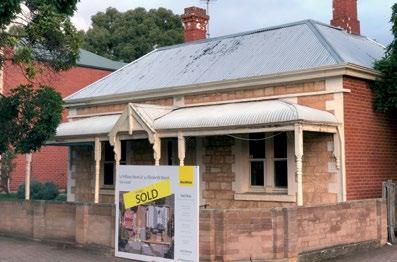 SANDY WILKINSON
SANDY WILKINSON
Qualified in both architecture and town planning, Sandy Wilkinson is a heritage consultant well known for his advocacy work seeking planning reform in South Australia and better protection for Adelaide’s built character. In this thought-provoking piece, he challenges the limited approach to conservation zones and listings endemic across Adelaide, which is patently failing to effectively protect our historic buildings and streetscapes.
Beyond South Australia’s State and Local Heritage items, countless historical properties remain unlisted even though most people, including developers, would reasonably expect them to be protected from demolition. The notion of heritage listing seems to be caveated with an assumption that it should encompass just a small representative collection of our history rather than constituting the very fabric of our State.
Some 2,300 State Heritage items, 7,000 Local Heritage Items and less than 12,000 Contributory Items are currently listed. By comparison, the State has 750,000 properties. So items listed under the three categories amount to less than 3% of all properties, and still the Urban Development Institute of Australia wanted it reduced to 1% by removing Contributory Items from the planning system.
Heritage listing and, notably, demolition protection have always been politically fraught. Whilst retention and adaptation of existing historic buildings is almost implicitly understood in the UK and Europe, in Australia the notion pervades that “my home is my castle and I can do what I bloody well want with it”.
This attitude has resulted in political capitulation when it comes to denying a property owner’s right to demolish their own home, a bit like the United States’ attitude to gun ownership. A motion carried without notice in 1993 at the first meeting of the newly-elected City of Adelaide council under Lord Mayor Henry Ninio, is testimony to that. It proposed council ‘take no further action to list any property where the owner had objected’. There was no rhyme or reason. If the owner said, “I’d rather it not be listed”, even if it was the proverbial ‘Taj Mahal’ in terms of heritage merit, it didn’t get listed. Over the coming years, many of those buildings were progressively and needlessly demolished.
In 2007, I was elected as an Adelaide city councillor, campaigning to have these buildings heritage listed once and for all, based on their merits. Walking the square mile from the corner of North Terrace and West Terrace to the corner of South Terrace and East Terrace, I identified 137 historical properties not even considered previously.
The Property Council was apoplectic and put pressure on the then Minister for Urban Development and Planning, Paul Holloway, who sat on the proposed listings. After John Rau became planning minister some years later, he made a decision to apply additional threshold criteria beyond those in the Act, as a justification to cull the already culled list. Ultimately just 37 (14%) out of 251 buildings originally proposed in the CBD were listed, and 67 (37%) out of 81 buildings proposed by Donovan & Associates Heritage Consultants in 2009, leaving the Adelaide square mile with manifestly inadequate protection.
In greater metro Adelaide, some councils encompassing historic suburbs responded to a call published in the South Australian Government Gazette in 2001, giving them the opportunity to designate Historic Conservation Zones and Contributory Items. Sadly, most country councils did not respond.
For those councils endeavouring to establish Historic Conservation Zones with Contributory Items, Planning SA (now DTI) placed quite arbitrary limitations on the extent. A case in point was the part of Norwood where I live, in the City of Norwood Payneham & St Peters (City of NPSP).
In 1995, heritage architect Mark Butcher undertook a survey for the then Norwood Council and proposed an Osmond Terrace South Historic Conservation Zone. The map (pictured bottom) indicates proposed Local Heritage Items (black squares), including my own house on Osmond Terrace. These items were all subsequently listed. The map also shows proposed Contributory Items (black circles), which remain unprotected to this day. Those since demolished are shown in blood red.
As a snapshot of the current extent of listings, I undertook a survey of the southern portion of Norwood bounded by Fullarton, Kensington and Portrush roads, and The Parade. Within this area there are about 1200 properties, of which 660 are pre-1940 housing stock that should be protected from demolition. However only 165 of these are listed and mapped in the council’s Development Plan as State or Local Heritage Items. Only another 82 fall within the limited Historic Conservation Zone, leaving 412 predominantly Victorian-era stone buildings unlisted and unprotected.

Historic Conservation Zones or Historic Overlays should overlap historic areas with a high degree of correlation, not just a small designated sample area. And yet the zone comprises only a tenth of the historic residential area. Outside the zone, only the gems are protected as individual Heritage Items, with the bulk of the houses that comprise these historic streets left unprotected.
In another example, my consultancy practice surveyed the entire City of Unley council area and established that 70% of building stock was original. Planning SA limited zoning so that only 23%of the council area was covered. Instead, a system of Built Form Zoning was introduced to protect ‘character’, with no scheduling of the buildings sought to be retained. As a result, 50 buildings have been demolished in the past five years – 10 times the rate of demolition of Contributory Items in the City of NPSP, where they are clearly identified.

Under-representation of heritage through listing and ineffective demolition protection is endemic across Adelaide. Too often, the fate of a building hinges on whether it is purchased by someone willing to restore it, instead of demolish it. Do we really want our heritage left to chance like this?
With a new State Government and the planning system currently under review, there is an opportunity to redress this situation and actively support councils so they can expand the extent of Historic Area Overlays to better protect historic housing stock. Urban consolidation, as sought under The 30-Year Plan for Greater Adelaide, can be achieved without losing Adelaide’s cherished historic stone buildings.
*Sandy Wilkinson is a director of Alexander Wilkinson Design.
Above:
Below:
Map showing an area of Norwood bounded by Fullarton, Kensington and Portrush Roads and The Parade, showing State and Local Heritage listed buildings (blue and green), and unlisted predominantly Victoria-era stone buildings (brown).

The year 2023 marks the centenary of the closing of the world-famous Moonta Mines on the Yorke Peninsula. Over the past year the Trust has been working on a major conservation and tourism initiative with funding from the Commonwealth Government that will be completed and progressively opened to the public over the course of 2023. This work at the Moonta Mines National Heritage place is also positioning the site for nomination to the UNESCO World Heritage list in coming years.




Moonta Mines holds a special place in Australia’s economic and cultural development and in the worldwide spread of Cornish culture and mining technology and skills.

Copper mining took place at Moonta Mines between 1862 and 1923. One hundred years ago, mining ceased after more than 60 years. Over that period, two generations of miners, engineers and other skilled tradespeople not only created one of the most profitable mines in the world, but also shaped a distinctive cultural identity firmly founded in the traditions, beliefs and practices of their Cornish origins.
In 1962 Moonta Mines born author, cartoonist and former miner Oswald Pryor coined the term ‘Australia’s Little Cornwall’ to describe the area of South Australia including Moonta, Wallaroo and Kadina, sometimes called the Copper Triangle or Copper Coast.
This year, the centenary of the closure of the Moonta Mines, the National Trust is re-opening the Moonta Mines site as a major heritage tourism destination. With funding from the Commonwealth Government, we have invested in major conservation works on some of the key remaining mining structures and are creating new visitor experiences and amenities to develop the potential of Moonta Mines as one of the state’s premier heritage tourism sites.
The Moonta Mines site stands at the top of the Yorke Peninsula on the land of the Nharangga people. Nharangga country encompasses all of the Yorke Peninsula west of Port Broughton and Port Wakefield (see map left). While Nharangga people are known to have been present at Moonta Mines in the early years of mining and some were employed there, the creation of the Port Pearce Aboriginal Mission shortly after in 1868 initially attracted some 70 Nharangga people. The Point Pearce Mission was taken over by the State Government in 1915.
Today, groups such as The Nharangga Aboriginal Progress Association (NAPA) are working to recover and share their language and cultural traditions. You can explore some the resources NAPA has created here: www.napainc.com.au
In this issue, we will introduce the Moonta Mines story and show what was achieved with the conservation works undertaken in 2022. Over the course of 2023, we will provide an update in each issue of Heritage Living about the new activities, events and amenities visitors to Moonta Mines can enjoy.
As the works at Moonta are completed, we are also progressing the nomination for Moonta Mines, alongside Burra, as the pre-eminent Australian Cornish Mining Sites (ACMS) for world heritage recognition. The ACMS are proposed for world heritage listing as an extension of the listing of Cornish mining sites inscribed on the world heritage list in 2006.
Nomination for world heritage listing is a complex and rigorous process administered by the United Nations Educational, Scientific and Cultural Organisation (UNSECO). The National Trust is working in partnership with the Copper Coast Council and Regional Council of Goyder to advance the world heritage nomination of the ACMS sites at Moonta and Burra.
Pictured opposite page:
Centre: Richman’s Engine House. Top and bottom rows, Hughes Engine House.

Left: Richman’s Engine House works.
Opposite: Cartoonist Oswald Pryor was born at Moonta Mines in 1881. Pryor chronicled life on the mines in cartoon form from the age of 20, having begun work in the mines at the age of 13. A collection of his cartoons was published in 1961 when he was 80 years old and two more books followed including “Australia’s little Cornwall” (1962) before his death in 1971. His vivid and often humourous caricatures of life at Moonta Mines, like the one here, are a remarkable historical resource.
 Port Broughton
Adelaide
50km
Port Broughton
Adelaide
50km
Moonta had its peak of production over the next twenty years into the 1880s. In 1880, Moonta was the largest settlement outside Adelaide, just as Burra had been in the 1840s.


In the 1860s and 1870s the most significant structures were built including the Wesleyan Methodist Church (built 1865 and with an ultimate capacity of 1,200) and the Moonta Mines Model School (accommodating more than 1,000 students) built in 1878. These two buildings were among the largest buildings of their type in South Australia at the time and continue to impress today.
Rapid industrialisation of the mines progressed at the end of the century and in 1900 new chemical technologies were introduced to extract copper from the accumulated heaps of crushed ore waste. However, a slump in copper prices after World War One had a rapid and fatal impact. The Wallaroo and Moonta Mining and Smelting Company went into liquidation in 1923 with some 2,000 workers losing employment. Most mines were soon abandoned and much of the equipment and infrastructure was dismantled or removed. It was the end of an era, one which had seen Moonta at the forefront of one of Australia’s first industrialised export enterprises and the global apogee of Cornish mining technology and traditions.
Below: Lithograph of Moonta Mines by William Wyatt (1862) shortly after mining commenced. Credit: State Library of South Australia, B 8126.The distinctive Cornish Engine Houses with their round chimney stacks are the dominant feature of the industrialised Cornish mining landscape. So too in Australia’s ‘little Cornwall’. In Wales, where there were more smelting works, they typically built square chimney stacks. It is said that the Cornish preferred a round design, without any corners to provide hiding places for evil spirits.
One of the most important and now best-preserved Australian Engine Houses is the one at Moonta Mines known as Hughes Engine House. It was built early on in 1865 for the specific purpose of ‘dewatering’ the mines, that is removing water from the mine shafts. As the mines went deeper into the ground (up to 750 metres at Taylor’s Shaft) the water table rose and the shafts and miners were at constant risk of inundation.
The famous steam driven Cornish beam engines underpinned the success of their deep, hard rock mining techniques. These powerful engines could be used to pump, haul and crush ore. Because of their importance the distinctive Engine Houses were carefully constructed to house these mechanical powerhouses. The 60-inch beam engine at Hughes kept the mine shafts on the Elder’s Line of Lode free of water. The beam action, with five strokes per minute, 24 hours a day, provided the mechanised heartbeat of the mines for almost 60 years.
In 2022 Hughes Engine House, Chimney stack, Boiler House and Balance Bob were the first to receive much needed conservation works. Little work had been done on these masonry structures over the last 30 years, but they remain in generally good condition despite being more than 150 years old. The work involved extensive masonry works to clean, repoint and replace stone as necessary, with great care being taken to accurately match the original mortars as far as possible.

Richman’s Engine House stands at the northern end of the Elder’s Line of Lode, the richest copper deposit at Moonta Mines. The need for an additional engine to crush and dress low-grade ore was identified by mine General Manger Captain Henry Richard Hancock in the late 1860s. A 32-inch beam engine was imported from Cornwall for the task and the Engine House, built with stone quarried from Moonta Beach, was completed in 1869.
It was at Richman’s that the world famous ‘Hancock jig’ was first put into use. This invention, patented by Hancock, revolutionised the sifting of crushed ore using a rapidly moving screen in a tank of water to separate the heavier particles, generating much higher yields of copper.


Conservation works at Richman’s Engine House completed in 2022 involved the replacement of the dilapidated roof and guttering and drainage systems and the fitting of stainlesssteel bird mesh on window openings to prevent bird entry. The roof has a new access system for maintenance purposes. In addition, a flagpole has been installed which can fly the Cornish flag – as well as others. Solar panels have been added to provide an energy system for interpretive installations and night time illumination. Stone and brick work has been repaired, repointed and replaced where necessary. A new public entry door has been installed which will provide access to an internal viewing platform.
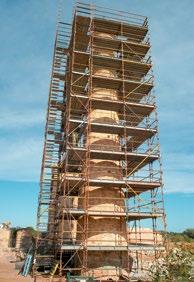

 Above: National Trust President Paul Leadbeter at the launch of works event at Hughes Engine House.
Above: National Trust President Paul Leadbeter at the launch of works event at Hughes Engine House.
It is hard to imagine heritage advocacy in South Australia without the ‘Help Save South Australia’s History from Demolition’ Facebook page. The page, though, would not exist without countless hours put in by one individual to ensure it runs smoothly.

Debbie Williams grew up surrounded by Victorian architecture, in a workingclass town in Northern England that could easily have inspired an L. S. Lowry painting. Debbie fondly recalls family outings to the stately homes of a bygone era. “I loved walking around seeing magnificent gardens, magnificent buildings, and I just always thought that they were special,” she says. These early experiences helped shape her appreciation for historic architecture.
Fast forward to 2013 and Debbie was asked to take over the ‘Help Save South Australia’s History from Demolition’ Facebook page by her friend Mark Wiseby. Back then, the page was modest still, requiring much groundwork. She decided to build it around certain themes – Where Am I?, Name the Architecture and Important South Australians.
“It seemed to be something that people liked and it’s nonconfrontational. I didn’t want it to be angry, angry, angry, angry, because you can promote activism, but you don’t want to be making people angry or sad,” she explains. Clearly, it has proven to be a successful formula with the page now boasting 8,000 followers.
For Debbie, saving heritage is not only about the Grande Old Dames, but also the humble cottage. “Humble beginnings bred some amazing South Australians – premiers, philanthropists, farmers. You know, people like that went on to do great things for our State.”
The Facebook page has been integral to many recent heritage campaigns in South Australia, such as the successful fight to save the Waite Gatehouse. For Debbie, the immense community response shows that people do care and that peaceful activism can work.
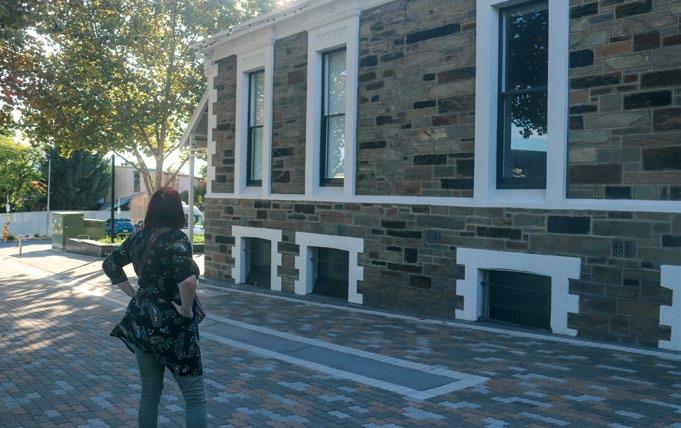
However, running the page does come with its challenges. Debbie has to constantly monitor messages and comments, which can be tiring given she works full-time. She is also aware that the site and its supporters are often up against powerful and sometimes hostile developers. This will not stop Debbie, who remains hopeful the page will continue to expand and evolve in new directions.
Help save South Australia’s History from demolition Facebook page: www.facebook.com/SaveSAhistory
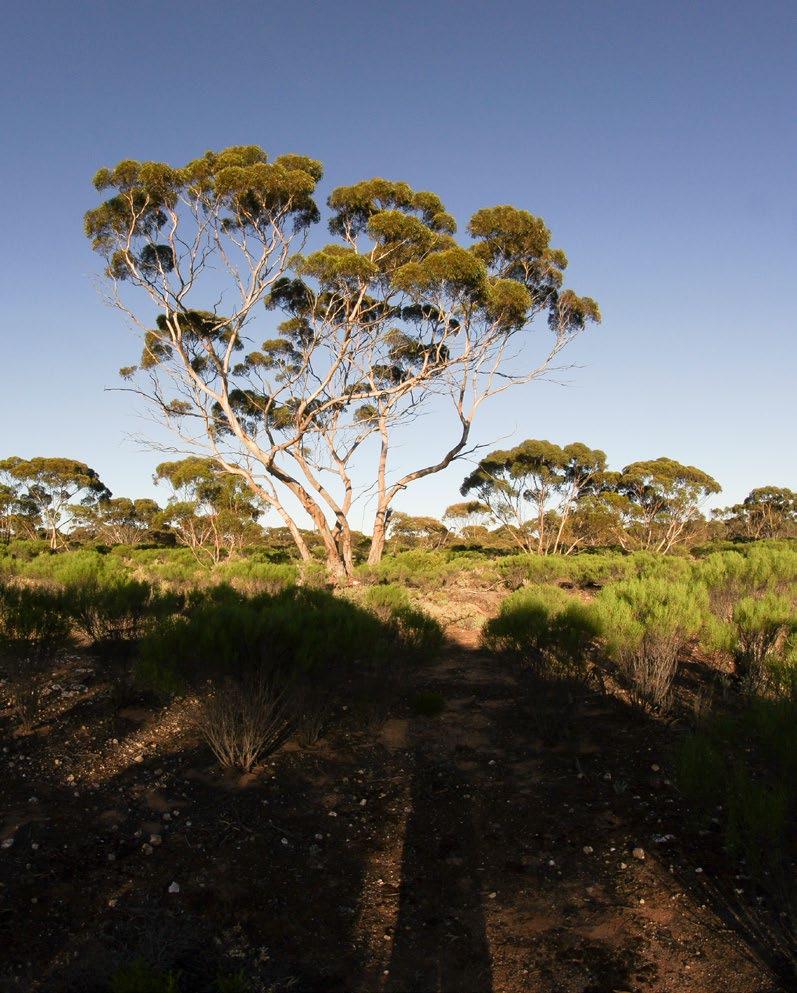
The Tree of the Year competition was established in 2021 by environmental advocate Tom Morrison. Known for his efforts to raise awareness about the importance of protecting our native vegetation and significant trees, Tom founded the popular Facebook page 20 Metre Trees, where he advocates for the value of large trees, particularly in urban environments.
An ABC Adelaide interview with him about this year’s competition saw the radio station’s talkback number flooded with texts and calls from people wanting to nominate their favourite tree. Listening to the discussion, it was evident that people considered them living entities with individual characters, rather than merely a part of the landscape. They not only provide important habitat for native fauna, but enhance the aesthetics of the places where we live and work, make a huge contribution to cooling our streets and homes, clean the air we breathe and boost our mental health.
These benefits were reinforced by members of the public when they nominated their favourite trees for this year’s award. People were encouraged to provide images and a brief description, as well as their views on why the tree deserved to win the title. Many different species in a variety of settings from across the State were nominated, from stately street trees passed by every day to majestic paddock specimens, and trees that stand out in bushland settings.
A short list was selected by the judging panel. Voting was then opened to the public.
A magnificent Red Mallee believed to be around 2000 years old has been voted winner of the 2022 South Australian Tree of the Year competition.
The 2022 winner is a venerable Eucalyptus oleosa, dubbed Fred O’Mallee by Brett and Marie Smith, from Ellura Sanctuary near Swan Reach. Fred grows on the couple’s 76-hectare property, which they maintain as a private nature sanctuary. They’ve spent the past 10 years identifying and documenting its diverse ecosystems – an effort which saw them win the 2022 Murraylands and Riverland Landscape Board Citizen Science Award.
The property incorporates old-growth mallee scrub and native pine forests harbouring an abundance of native flora and fauna. At last count, according to Brett, they’re at 1,200 species, and still going!
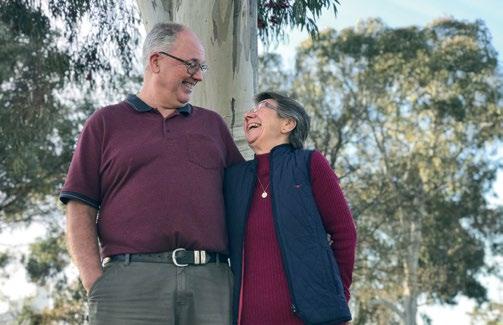
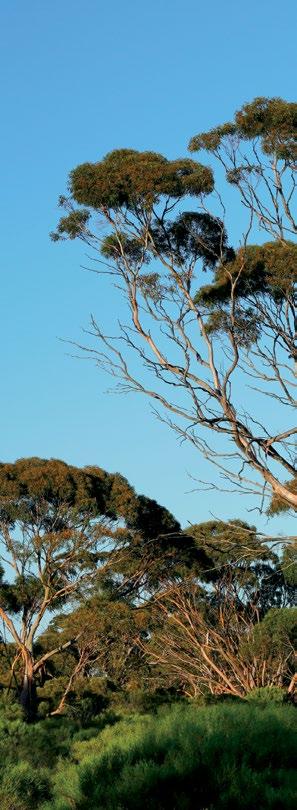
Their favourite single specimen is Fred O’Mallee. They noticed the tree the very first day they walked the property, because he dwarfs everything else on Ellura. Typically, Red Mallees grow up to twelve metres in height. Truly a giant of the species, Fred is a towering 19 metres tall, with a crown spread of about 29 metres. It is impossible to put your arms around some of his branches let alone his base. His real trunk, or lignotuber, is mostly underground but the above ground section measures more than 12 metres in circumference.

“He stands proud on the side of a small hill and fills it with his presence. It wasn’t until years later we were given an estimate of his age to be 2,000 years. We were shocked! When you think of the human history that has occurred in that period of time, and he’s just stood there proud, surveying his land, helping and supporting its inhabitants,” says Brett.
“He made such an impression, we had to give him a name. Fred – a simple name that belied his grandeur. When we showed our son, he said he needed a second name. ‘Fred O’Mallee!’ he declared, as in ‘Oh, what a Mallee’. It has stuck ever since. We claim him to be the biggest Mallee tree in Australia, and many have gone away to disprove us; but all have failed to match his presence. However, we are pleased because it encourages people to go out in nature and look.”
Aside from Fred O’Mallee, Eucalyptus oleosa has several common names such as Giant Mallee, Red Mallee and Oil Mallee. The species is widespread across southern Australia, from South Australia to Western Australia, Victoria and New South Wales. As might be expected from the name, high levels of oil are contained in its leaves, although they are no longer used for oil production.
Importantly, the species provides habitat for a wide range of fauna in the Murray Mallee, extending shade and shelter in an environment where temperatures can drop as low as minus 6 degrees Celsius on frosty nights and climb to a scorching 50 degrees in summer. In Fred’s case, brown falcons, Australian ravens and galahs have all nested in his tall branches. Purplecrowned and musk lorikeets visit him regularly as do thornbills, ringnecks, wee-bills, bronzewings and geckos.
“We do a lot of weeding, so there’ll be times when we walk past every day, and others where we won’t see him for months at a time. Because we are conservationists, we recognise regular visits are unhealthy as it disrupts the wildlife. It’s important to let them go about their business without human interference,” Brett explains.
The Smiths were “stoked” when Fred won the Tree of the Year competition after being encouraged to enter him by a supporter of the sanctuary. “A number of people have commented they were amazed and so happy a mallee tree won,” Brett says.
For more information about Ellura Sanctuary and the species found there, visit www.ellura.info

Top and above: The tree on private farmland in the Eden Valley.
Below: The Lockleys tree, with new paving being installed.
The finalists in the 2022 South Australian Tree of the Year competition were predominantly natives, with one species proving particularly popular. A significant number of the trees nominated were River Red Gums.

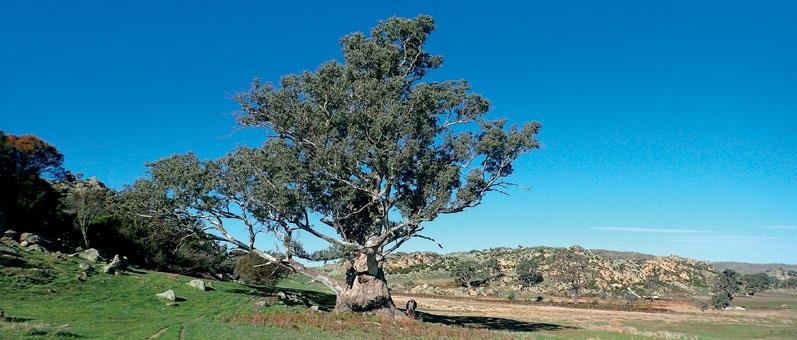
Their popularity with the general public was also borne out when the species was voted Australia’s favourite tree in an online poll organised by the ABC for National Science Week in August. Eucalyptus calmaldulensis scored more than 31,000, or 18 per cent, of the almost 270,000 votes cast, making it a clear winner.
Finalists in our own South Australian competition included a tree at Happy Valley, estimated to be about 400 years old and 18 metres tall, with a trunk circumference of six metres. It stands on a block of land chosen by its owners as the site for their new home, because of the tree. “Many native birds use the multiple hollows and a variety of birds visit daily. The large canopy protects our garden, giving shade in hot weather. The tree is a survivor of the area cleared for vineyards, then subdivided for housing,” the nominee explained.
Another urban contender was a tree at Lockleys, set in a roadway. Surrounded by bitumen for years, the tree and two nearby “siblings” recently benefited from new and more thoughtful landscaping. The road was reshaped to give the trees more space, and the bitumen replaced with permeable pavers. “Now, effectively the entire footprint of road under the drip line of these three significant trees has a surface which will breathe and allow rainfall to permeate into the surrounding ground and help sustain vibrant tree health. No longer is there tension between the urban and the living,” explained the nominee.
Another finalist was a tree situated in the picturesque Eden Valley, whose hollowed out base is large enough to accommodate several people. With a trunk circumference of 14 metres, it is considered one of the largest in the Mount Lofty Ranges. It stands on private farmland and has an old wedge-tailed eagle’s nest in its upper canopy.
The most popular example of a River Red gum, coming in at number four in the competition, was a street tree at Clarence Park, measuring eight metres around its circumference, 24.5 metres tall and with a canopy spread of 27 metres. “A real traffic stopper, in every sense of the word!” explained arborist Dean Nicolle, who nominated it.
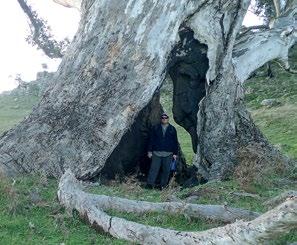
Above: The most popular example of a River Red gum in this year’s competition, a street tree at Clarence Park (photo by Dean Nicolle).
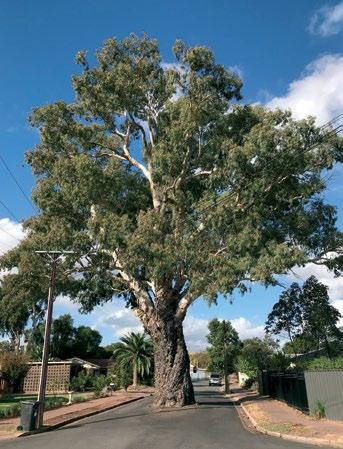
Below: Looking up into the canopy of the majestic Happy Valley nomination.
A research project carried out by the University of Adelaide’s Environment Institute has confirmed that Adelaide is losing trees at an alarming rate, with potentially devastating consequences for the liveability of the city.
The South Australian Attorney General’s Department commissioned the Environment Institute to investigate urban tree protection laws across Australia, to support a major review of the State’s planning regulations. The research was carried out by PhD candidate Rikki Belder; senior lecturer Kate Delaporte (Curator of the Waite Arboretum & Waite Conservation Reserve) and School of Biological Services adjunct lecturer, Dr Stefan Caddy-Retalic.
Completed in May and released to the public in September, it confirmed trends identified in a previous study of tree regulations in 47 metropolitan local government areas, released in December 2021 by the Conservation Council of SA, in partnership with the National Trust, the Australian Institute of Landscape Architects, the Nature Conservation Society, Trees for Life and Treenet.
The latest study compared the tree protection laws of 101 local governments in capital cities, as well as state-level regulations across Australia. It analysed how protected trees were defined; exemptions to rules that protect trees; and how permit fees, bonds and penalties are used to improve tree protection outcomes.

The research project found that the vast majority of local governments reviewed were empowered to set and police local laws, in addition to state level protections. By comparison, South Australian councils are responsible for enforcing the State Planning and Design Code. Currently in South Australia, trees qualify for protection once they reach a trunk circumference of two metres, with trees of particular species, or those located close to structures, exempt from protection. South Australia’s laws were found to be markedly less stringent than those of local governments in New South Wales, Victoria and Western Australia, where protection often kicked in for much smaller trees, some with a circumference of only 5cm, but with an overall average of 50cm. By contrast, South Australia’s protections kick in at a comparatively large 2 metres. According to a University of Adelaide blog, the findings are likely to influence revised planning laws, with Planning Minister Nick Champion promising to create rules that match the strongest in Australia.
The full report is available at www.plan.sa.gov.au/__data/ assets/pdf_file/0011/1087886/Urban_tree_protection_in_ Australia.pdf
Honorary curator Peter Foster continues his personal account of the story behind the National Trust’s horse-drawn vehicle collection and the challenges faced in the late 1970s after a heady start.
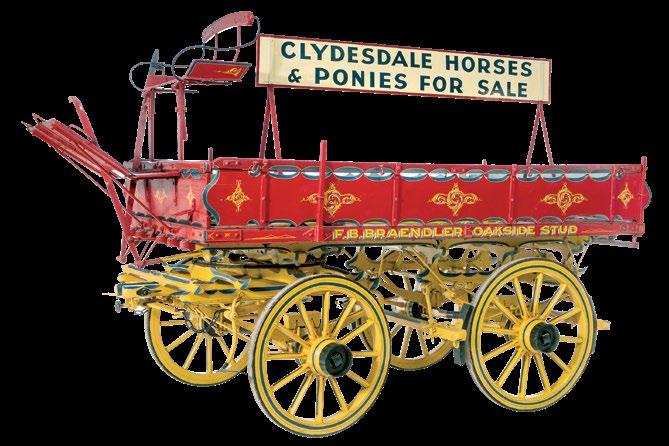
In my first article (Heritage Living, Autumn 2021) I acknowledged the enormous and far-sighted contribution of both Clive Corbin and Tom Downer in amassing a rare and representative collection of horse-drawn vehicles. From what seemed a solid beginning, one decision saw that position collapse.
After forming a collection committee with Clive Corbin as secretary, the team of Corbin and Downer quickly established a collection of 30 plus vehicles. For the time, this was a most significant cohort. Some came to the collection as donations, others were purchased and a small number were provided on long-term loan.
Unlike Clive Corbin’s youthful collection of stamps, horse-drawn vehicles need considerable display space. Fortunately, such space became available through the Municipal Tramways Trust, which was vacating its Maylands tram barn on Magill Road. The site was a perfect display venue.
This good fortune continued when it was decided to present the collection to the South Australian public as part of the 1966 Adelaide Festival of Arts. Eager to be seen in the public domain, the then Attorney General, Don Dunstan, agreed to officiate at the collection’s official opening.
Ongoing success seemed assured; a solid foundation was established as more vehicles were added. Clive Corbin’s collecting skills had been well honed and, in conjunction with Tom Downer’s contacts in the horsey world, the newly-formed National Trust, under the presidency of Hurtle Morphett, continued to save significant examples of Australia’s oldest land transport system.
Unfortunately, the euphoria was short lived. In the late 1970s the very person who had opened the collection closed it for political gain. Don Dunstan thought the Maylands site more suitable for a retirement village, the first in his electorate of Norwood. The collection was now homeless.
From this time until 2006 the hapless vehicles were moved from one unsuitable site to another. During this period of uncertainty, donors of loan vehicles re-claimed them. Subjected to regular moves, the remaining vehicles were damaged; items that were once in sound original condition were no longer so.
Respite was gained for three years when the vehicles were housed in the Seppeltsfield winery complex. An area in the old distillery allowed some of them to be displayed to the public and the remainder were housed in reasonably stable conditions in the former keg storage area. The collections seemed to have found a home.
It wasn’t to be. After taking over the Seppeltsfield operation, Southcorp requested that the collection be removed. Despite more time being granted, the collection had to be divided into small lots and dispersed to various locations, most of them unsuitable.
Eventually, in 1995, a site was found at a former wool store in Port Adelaide – a commodious site with a wooden floor and stable temperature. The collection languished there, gathering dust, while various feasibility studies were conducted and alternative options pursued by the National Trust, headed by director Rainer Jozeps and President Lou Owens.
Perhaps fearing the predicament would continue, in 2002 Glenda Couch-Keen, a long-serving stalwart of the horsedrawn vehicle committee, wrote and published Tom Downer’s Legacy. The book was an immensely informative account of the collection, its history and Tom Downer’s association with it.
Unknown to all who were engaged with the collection’s care, a series of seemingly unrelated events was to change the future of this now depleted and bedraggled collection of significant vehicles. From the dim recesses of a dusty former wool store in Port
Adelaide the vehicles came to see the light of day after almost 40 years of temporary accommodation. In the midst of the stalemate a most unlikely solution had surfaced.
Sandra Morton, a librarian in the history annex of the Port Adelaide library, was well aware of the vehicles and their predicament when she met with Employ SA project officer Nunzio Giurastante. Employ SA was seeking a serious project for a Work for the Dole program it wanted to establish. It appeared, through Sandra, that they
Government re-employment scheme. As supervisor, it was a very rewarding experience working with untrained and inexperienced individuals who were prepared to listen and undertake various tasks in the broad areas of wood skills, painting, steel fabrication and leatherwork. Amazing results were achieved. One by one the vehicles were taken from the dim recesses of the old wool store and given a new lease of life.
As the project neared completion, uncertainty still remained about where the now attractive collection would be housed. Previously unwanted, it was now in demand. Various Trust branches expressed interest in one or more of the vehicles as desirable additions to their museums but only one proposal promised to retain the collection as
It was tabled by John Northwood, Chair of the Trust’s Millicent Branch. He argued that a strong culture of appreciation for horse-drawn vehicles had been nurtured since Dr David Harris founded the branch. The Millicent proposal had my support as it seemed outrageous to disperse a collection that had hung together so precariously for
Within days of the meeting, I became involved with the proposed project. A plan involving Employ SA, the National Trust and myself was formulated with the aim of restoring the rapidly deteriorating vehicles. The proposal was submitted to the National Trust Executive by Employ SA, with all parties agreeing that it could proceed.
As I was about to retire, I became the project manager and, in May 2004, the restoration and conservation of the 26 vehicles commenced.
In a project spanning two and a half years, all the vehicles were restored by people involved in the Commonwealth
The Millicent branch achieved the outcome it sought. Undaunted by the huge task of transporting the 26 vehicles some 400km, in 2010 John Northwood and Barry Long moved them on trailers, two at a time, from Adelaide to Millicent. A quote from one source estimated the cost of the move would be close to $20,000. The stalwart team at Millicent moved the collection for just $7,000.
With such resolve, it is little wonder that over the past 12 years, the collection has come to be regarded as the most representative in Australia of the country’s horse-drawn transport era.

Visit the horse-drawn collection at the Millicent National Trust museum.
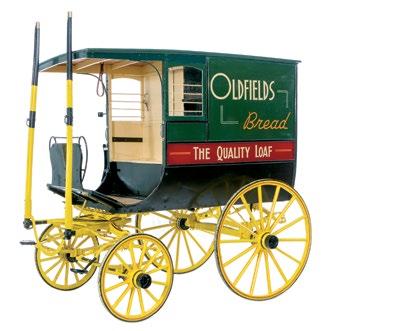

This edition’s feature dress from the National Trust Costume Collection provides a glimpse into the life of a fascinating woman who had an international career on the stage, and managed one of Adelaide’s best-known theatres.
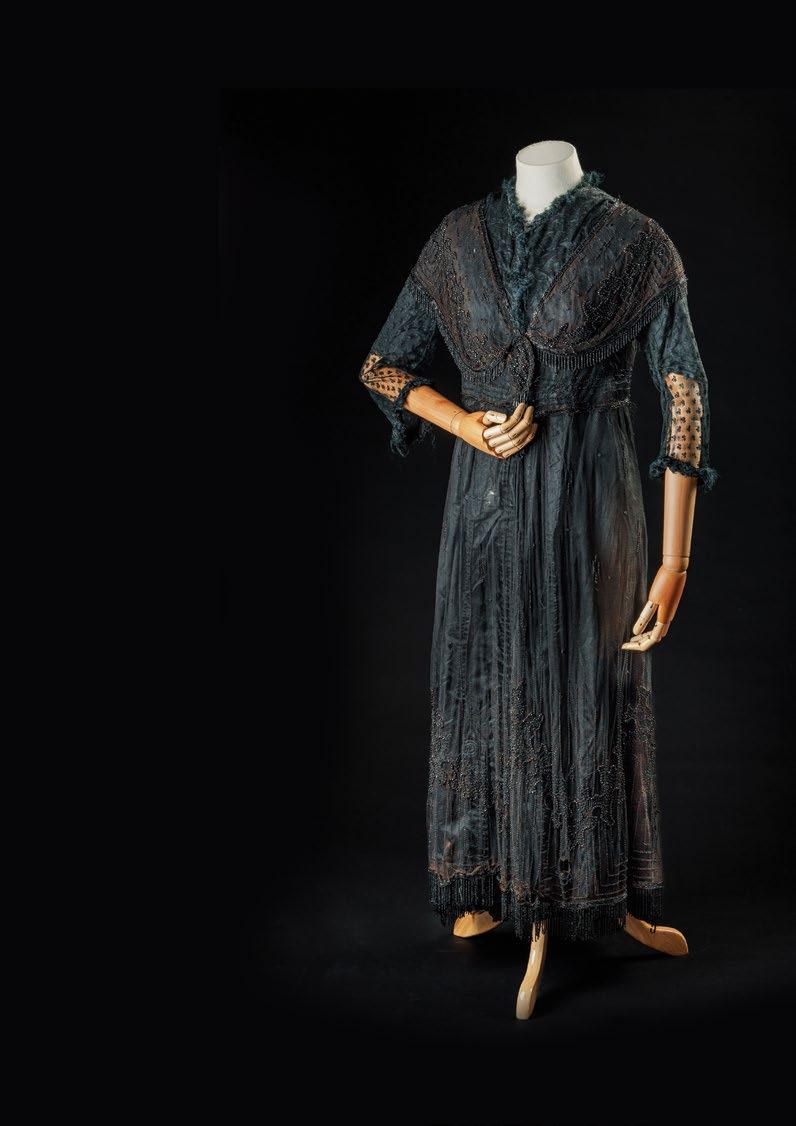
By her own account, Mary Hele led an exciting and colourful life. Mary was born in 1843 in Western Australia. Her mother, Mary Anne Pettit, had migrated from England as a child with her family, aboard the first ship bringing founding settlers to the Swan River colony. Her father, Abraham Myers, was an American who became printing overseer of The Advertiser and The Chronicle in Adelaide.
Mary spent her youth with relatives in Melbourne where she took dance lessons and began appearing on the stage under the name Mademoiselle Louise. In 1867, she toured New Zealand with Cooke Zoyara and Wilson’s Great World Circus. A talented horsewoman, she played a leading role in an equestrian theatre spectacle staged by the circus, based on Mazeppa, a poem by Lord Byron. The agent overseeing the company was her future husband, Frederick Hart Pollock (also spelt Polak), an up-and-coming theatre manager born in Wales.
The company later toured India, Pakistan, China, Sri Lanka and South East Asia. In Pakistan, they travelled by camel for three weeks after an uprising disrupted rail services. In India, Mary appeared with a gymnastic and pantomime act that specialised in ‘statuesque ballet’. She recalled a rajah presenting her with an exquisite black diamond ring after the company performed at his palace. At Agra, she volunteered to visit a remote British army station and ‘cheer the men’, who were dying of cholera.
After a long engagement, Fred and Mary married in Singapore in 1875. They travelled to England and America before returning to Australia four years later. A trained actor, Fred appeared in a comedy drama in Melbourne but his main career was in theatrical management, looking after acts and touring variety companies in Australia and overseas.
The Pollocks moved between Melbourne, Adelaide and Sydney before eventually returning to Adelaide in 1899 to run the Theatre Royal Hotel in Hindley Street. The following year, Fred also leased the neighbouring Theatre Royal.

With a capacity of 3,000 people, the elegant building featured a blue-domed ceiling speckled with gold stars and plush white and gold seating in the dress circle, embroidered with red. The theatre hosted the first public film screening in South Australia in 1896, but it was mainly a venue for live performances. Sarah Bernhardt, Laurence Olivier and Vivien Leigh were among the stars who graced its stage before the building was demolished in 1962 to erect a car park.
Mary took over managing the Theatre Royal after Fred died in 1908. In her mid-sixties, she was assisted by her nephew, Herbert Myers, who had lived with her since he was fourteen and knew her as Aunt Polly. He had worked alongside Fred for many years and continued managing the theatre after J.C. Williamson Limited took over the lease in 1913.
Sitting in her private box, Mary never failed to attend first-night performances at the theatre. Her retirement was
Above: The Theatre Royal on Hindley Street c 1866. Credit: State Library of South Australia.
Left: Interior of Theatre Royal, Lithograph, 1878. Credit: Arts Centre, Melbourne.
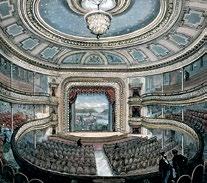
marked with a special ceremony on the stage, where the Mayor of Adelaide, Lavington Bonython, presented her with an illuminated address on behalf of friends and patrons.
In part it read: “Today you retire from a position certainly unique in Australia, as lessee of an important centre of entertainment and education – a post rarely occupied by a lady – but in it you have displayed fine qualities of enterprise and tact and courtesy that have made the Theatre Royal one of the most notable amusement houses in the Commonwealth.”
By then Mary had married again, to Henry Hele, who was chief accountant at The Register, where he worked for more than 60 years. Apparently, Henry was a “sweetheart of her youth”, so their marriage in 1911 was “somewhat in the nature of a romance”. Mary died in September 1925, one day after her 82nd birthday.
Music this year put an extra spring in the step of walkers participating in one of the National Trust’s most popular annual events – the Pioneer Women’s Trail Walk.





When women walked from the pioneer settlement of Hahndorf to sell produce in Adelaide some 180 years ago, they often sang hymns to keep up their spirits. People who retraced their steps in this year’s highly successful Pioneer Women’s Trail Walk were similarly encouraged by musicians performing at several stops along the way.
McLaren Vale folk musician Dave Clark performed with his band at the starting point in the centre of Hahndorf. In Bridgewater, Gerry’s Ukulele Band brought a festive air and at Stirling music was provided by the Argy Bargy Bush Band.
This year’s participants also encountered the ‘ghost’ of Eleonore Pfeiffer, one of the pioneer women who made the original trek. Eleonore’s great great grand-daughter, Madryn Silverlake, dressed in colonial costume to bring Eleonore’s story to life.
This annual National Trust event has come a long way since around 150 people participated in the first walk. 2022 saw almost one thousand participant registrations with about two-thirds of the walkers electing to complete the entire 26 kilometre route.

Hahndorf branch member, Lyndell Davidge, credits the growth in interest to the strong sense of connection between the present and the past provided by the event, and the enthusiastic support of some 30 volunteers and advances in marketing and ticketing for the event.
The walk celebrates the endurance and history of pioneers in the Hahndorf area, particularly the women and girls who carried heavy baskets of fresh vegetables, butter and eggs into Adelaide for sale during the first years after German families settled in the area in 1839.
They usually set out at around midnight, following paths used for millennia by the local Kaurna and Peramangk people, which passed along ridges and spurs, through Stringybark forests and down into the Beaumont foothills. First-hand accounts from the period reveal that the women often sang Lutheran hymns as they made their way, especially over the more difficult terrain. As they approached the centre of Adelaide, the women would stop at a stream to tidy themselves before offering the produce for sale in the streets, where it fetched healthy prices because of a general shortage of fresh food. Money in hand, they bought provisions and returned home.
The trail they followed was resurrected by a team of National Trust members in April 1980, after the discovery of a map dating back to 1841. Whilst the trail has had to be adapted to take into account building developments and modern boundaries, it remains as faithful as possible to the original.
2023 Pioneer Women’s Trail Walk is Sunday 21st May. Register now and start planning your trail adventure visit: www.nationaltrust.org.au/event/2023-pioneer-womens-walk/


With travel restrictions lifted, why not explore where your National Trust membership can take you? In the first of a new series, we look at just some of what’s on offer to National Trust members in Scotland. Explore what’s on offer to you, at reduced or free entry, through your membership.
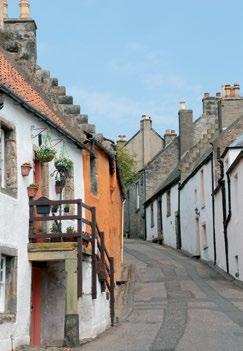
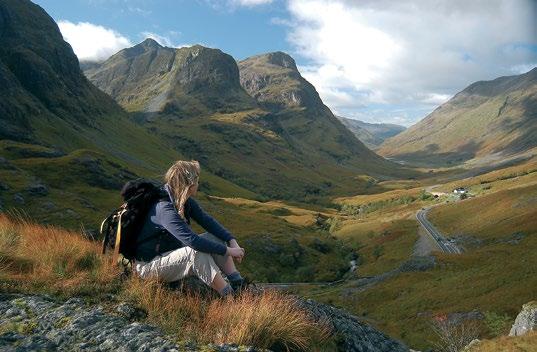
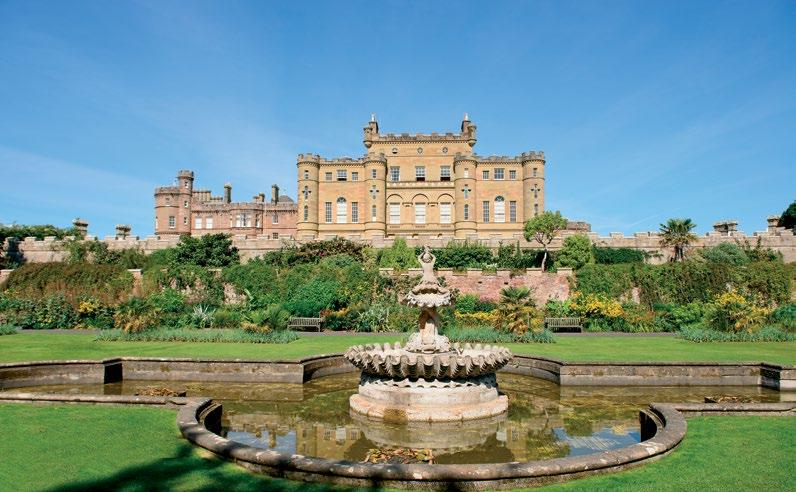 PICTURED:
PICTURED:
Founded more than 90 years ago, the National Trust for Scotland cares for some of the most magnificent buildings, collections and natural habitats in the country. An army of volunteers and staff bring to life around 90 properties, 300,000 artefacts and more than 76,000 hectares of countryside and gardens.
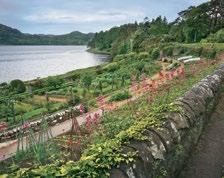
The most popular sites include the glorious estate of Culzean Castle, the birthplace of national poet Robert Burns, stunning Glencoe National Nature Reserve, the island home of the UK’s largest colony of Atlantic puffins (St Kilda), and the battlefields of Culloden and Bannockburn. There are also many lesser-known attractions well worth taking time to discover, such as Inverewe Garden, the burgh of Culross and The Tenement House in Glasgow.
Set on a clifftop overlooking the South Ayrshire coast, Culzean Castle was designed by famous Scottish architect Robert Adams in the eighteenth century for the Kennedy family. An oval staircase forms a dramatic centrepiece in the neo-classic building, whose entrance hall boasts one of the largest collections of British military flintlock pistols in the world. Wander the castle’s magnificent 260 hectare estate, which incorporates woodland, beaches, a deer park, flamboyant formal gardens, a walled garden, glasshouses, secret follies and adventure play areas for children.
For some of Scotland’s most dramatic scenery, head to Glencoe in the heart of the Highlands. This famous landscape has featured in many films such as Skyfall and the Harry Potter movies, but make sure to set aside time for a visit to the eco-friendly visitor centre to find out more about its haunting real-life history as the scene of a tragic massacre in 1692. For nature lovers, pack your hiking boots and follow some of the 60 kilometres of walking trails in the reserve, go on a safari with one of the Trust’s rangers, or even climb one of the eight Munro mountains that tower above the glen.
For garden lovers, there are dozens of choices across Scotland. One of the most astonishing is Inverewe, a loch-side garden lovingly created by a father and daughter amid a barren wilderness on the Atlantic Coast in the North West Highlands. A demonstration of creativity and experimentation in a challenging setting, it features rare and unusual plants gathered from around the world, including Wollemi pines. An exhibition in the summerhouse also gives visitors the chance to find out more about the area’s amazing marine wildlife and its maerl beds – Scotland’s coral reef.
Fans of the hit television series Outlander might like to visit the royal burgh of Culross, 22 miles north-west of Edinburgh, which served as the fictional village of Cranesmuir. Scotland’s most complete example of a burgh of the seventeenth and eighteenth centuries, this picturesque village boasts white-harled houses with red-tiled roofs, cobbled streets and a hilltop abbey. In the centre is an ochre-coloured palace with a beautifully reconstructed vegetable garden inhabited by rare Scots Dumpy hens.
For a city-based experience, head to Glasgow and explore Holmwood, the extraordinary 1850s family home of paper magnate James Couper. Designed by Alexander ‘Greek’ Thomson, it displays his penchant for Grecian styling and symmetry, and opulent decoration echoing the colours of ancient Greek temples.
Experience a very different standard of living at The Tenement House, where four rooms appearing as if frozen in time provide a rare glimpse into middle-class life in early twentieth-century Glasgow. For more than 50 years, this tenement was the home of shorthand typist Miss Agnes Toward, who preserved her furniture and possessions with love and care, holding on to all sorts of things most people threw away. There is even a jar of plum jam made in 1929!

There are so many National Trust sites to choose from in Scotland: explore the options before you leave, via the National Trust for Scotland website - www.nts.org.uk
Travelling the world with your NTSA membership
Being a member of The National Trust of South Australia gives people the satisfaction of knowing they are helping to preserve and promote South Australia’s natural and built heritage. It also offers benefits for members travelling interstate or overseas.
A NTSA membership card allows people to enter sites cared for by organisations that belong to INTO (International National Trusts Organisation), as part of a global reciprocal visiting scheme covering more than a thousand localities.

Free or discounted visiting rights have been negotiated as part of INTO’s mission to promote the conservation and enhancement of the heritage of all nations for the benefit of people around the world.
For a full picture of where your membership can take you, visit www.into.org/places/

Our members are the lifeblood of the National Trust. We need your support more than ever. The benefits of membership include free entry and discounts to National Trust properties across Australia and around the world. We encourage you to sign up a new member and extend your membership to support the National Trust.

Individual (One Adult) $65 $176
Individual Senior (One Adult aged over 60 years) $60 $162
Individual Concession (One concession card holder or full time student) $45 $122 Household (Two adults and up to 4 children under 18 years) $95 $257 Household Senior (Two Adults aged over 60 years and up to 4 children under 18 years) $85 $230 Household Concession $75 $203 (Two concession card holders or full time students and up to 4 children under 18 years)
Mr/Mrs/Ms/Other: First name: Surname: Address: Phone (Home): (Work): (Mobile): Email: Date of birth / /
Name of second household member
Mr/Mrs/Ms/Other: First name: Surname: Email: Date of birth / / Full Time Student or Pension Card Number (if applicable) 1 2
Gift membership Only: Tick this box if you would like the gift membership gift pack to be posted to you at your address. Please provide details below.
Mr/Mrs/Ms/Other: First name: Surname: Address: Phone (Home): (Work): (Mobile): Email: If you would like your membership to be affiliated with a ‘Local Branch’ please tick
Conditions of membership
Concession memberships apply to Australian Pensioner, Concession Card holders, Healthcare Card holders, Disability Concession and full-time students. Memberships are not transferrable. Only the person named on the card may use it. Your current membership card must be presented to gain free or discounted entry.
South Australian botanist Ann Prescott is the author and illustrator of It’s Blue with Five Petals, a popular guide which has been helping people to appreciate wildflowers in the Adelaide Hills region for more than 30 years. In this piece written for Heritage Living, she challenges us to take the time to pay attention to the little details that captured so faithfully in her book.
Remember to look at tiny things. Really look at them. It is the tiny things that hold our natural world together.
On this bit of stem of Blue Boronia (pictured), did you notice the tiny ‘nipple’ on each petal tip? And the eight yellow pollen sacks per flower held up by flattened white filaments, each with rungs of wee side hairs? And how the flower bud seems bluer and cradled in four sepals?
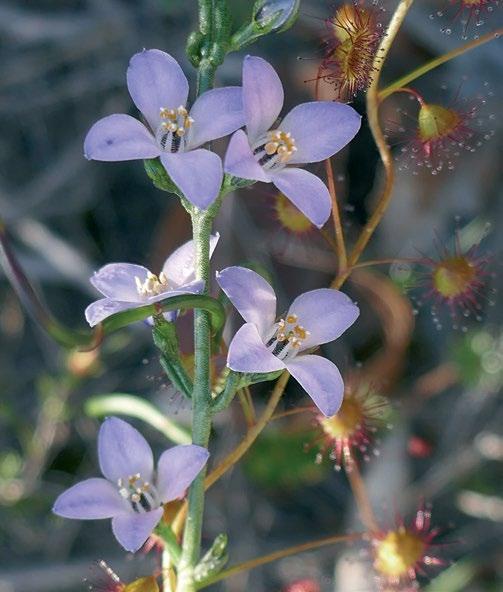
A thread-thin stalk of the Climbing Sundew snakes around the same twig, using it as a climbing ladder. The leaves are a perfect semi-sphere shape and around the rim, droplets of sticky trapping fluid on each maroon hair-like extension. Glistening. A green segment of Twining Fringe-lily stem makes one loop around the Boronia twig, cupping two petals as it passes, and then exits stage left.
It is the tiny things, the billions and billions of tiny things and tiny interactions, that build the natural world; from the understorey up. They hold the system together. It is not just about trees and koalas and large kangaroos. It never has been. This is how the world works………
A birthday cake is a birthday cake. A birthday cake with candles on top is a birthday cake. A birthday cake with all the ‘understorey’ cake eaten away, leaving a few crumbs is not a birthday cake any longer.
A habitat is a habitat. A habitat with trees on top is a habitat. A habitat with all the understorey eaten away, leaving only a few crumbs is not a functioning habitat any longer. Understorey holds habitats together.
I understand that kangaroo numbers are now estimated to be 20 to 30 times the land’s carrying capacity – abundant because of ‘European’made increases to water supply and suitable feed in our environment. If we unconditionally admire large mobs of resident kangaroos grazing and browsing in bushland, we run a real risk of losing not only countless tiny plants in the understorey but also the animals dependent on it.
As an ecologist, I have been watching our bushland for 50 years. I think that over-grazing in bushland by overabundant large kangaroos is now one of the greatest threats to the long-term survival and integrity of our bushland in the Adelaide Region, along with deer and goats.
Neither prison nor hospital, the “criminal ward” of the former Glenside Mental Hospital occupies a unique place in South Australia’s history. From the rare ‘Ha Ha Wall’ encircling the building to its striking 1880s polychromatic brickwork, explore the breathtaking architecture and sobering history of this important site.
Saturday 11 February
Sunday 26 February
Time: 2.00pm
Cost: Adults: $15 Concession: $13 NT Members & children aged 5 –15: $10 *not recommended for children under 12 Place: Z Ward Via 63 Conyngham St, Glenside Enquiries: bookings@nationaltrustsa.org.au or 8202 9200 Book online at: bit.ly/zward
Discover Stangate Garden, one of the hills best kept secrets. Bring along provisions for a picnic and spend the day enjoying the tranquil garden setting.
Sunday 22 January
Sunday 26 February
Sunday 26 March Sunday 23 April Sunday 28 May
Time: 11am – 3pm
Cost: $8 Adults FREE for National Trust members, Children under 15 FREE, Group, up to 4 $20 Place: Stangate House and Garden 3 Edgeware Road, Aldgate Enquiries: bookings@nationaltrustsa.org.au or 8202 9200
More information: www.nationaltrust.org. au/places/stangate-house-and-garden/ Payment accepted at the gate on the day.
Cape Jaffa Lighthouse Tours

Originally situated on the Margaret Brock Reef, 8kms out to sea from Cape Jaffa, this lighthouse became Australia’s first lighthouse to be dismantled and re-located onshore. The historic lighthouse was 41 m high and known as a Wells’ Screw Piledesigned to ideally suit the local conditions. The 8 roomed dwelling accommodated two lightkeepers and families with enough stores to last several weeks. The First Order Dioptric lens produced a beam which could be seen for 40 km.
Daily tours available on the hour, 26 December – 29 January 2023. At all other times, please call to book a tour.
Cost: Adult: $15.00
Children (aged 5-17): $7.00 Under 5: Free; Family (2+2): $25.00 Additional children $3.00
NT Members: FREE Place: 32 Marine Parade, Kingston SE Enquiries: 0427 854 175
More information and bookings: www.capejaffalighthouse.org.au/tours/
Journey through winding hallways and underground chambers to meet the colourful characters and deep history behind one of Adelaide’s oldest colonial buildings. From riots to floods to historic reforms the Treasury sat at the heart of South Australia’s political life - come and explore its secrets and forgotten stories!
Sundays Time: 1.00pm & 3.00pm
Cost: Adults: $15 Concession: $13
NT Members & children aged 5 –15: $10 *not recommended for children under 12 Place: Adina Treasury Hotel

2 Flinders Street Adelaide Enquiries: bookings@nationaltrustsa.org.au or 8202 9200
Book online at: bit.ly/TreasuryTours
The garden and grounds at Beaumont House provide a fascinating glimpse into colonial life in SA. The land was purchased by Samuel Davenport in 1846 but leased to Augustus Short, the first Anglican bishop of Adelaide, who in 1849 built a small cottage and lived there until 1856 when Davenport and his wife Margaret moved in. Davenport was an enthusiastic and enterprising farmer and experimented with growing olives, wine grapes, fragrant plants to make perfume, and mulberry trees to raise silkworms. Many of the trees Davenport planted are still standing - the heritage-listed olive grove, huge stone pines, pencil pines, palms, almonds, pears and fig trees.
First Sunday of each month (except January)
Time: 2.00pm – 4.30pm Cost: Adults: $15 Concession: $12
Children under 18 FREE NT Members: $7 for afternoon tea Place: 631 Glynburn Road, Beaumont More information: www.nationaltrust.org. au/event/beaumont-house-open-day/
Moonta is ready for the school and summer holiday influx of visitors to the Moonta Mines National Heritage Place. The very popular Moonta Tourist Train is attracting record visitors who enjoy a 50-minute train ride with commentary through this historic Cornish Mining site.


Moonta Lolly Shop is a special destination for anyone visiting Moonta – young and old – with many taking the younger generation to see where their grandparents bought their lollies. Housed in the old Moonta Mines Post Office this unique little shop sells a range of old-fashioned lollies and their signature “Spuds” are a big hit.


We are really excited to introduce our Moonta Pasty Cart this summer – this unique cart (created to look like a Cornish Pasty) will offer great coffee, cool drinks, Cornish Pasties, toasted sandwiches and the ever-popular Cornish Cream Tea and Saffron Cake. Golden North ice cream will be available in cones to visitors to this major tourist attraction of the Copper Coast of South Australia. Sit and relax or take away whilst you explore the heritage and history of this place.
Our Moonta Mines Museum (once the Moonta Mines School) will have special games areas set aside for the children to enjoy; old fashioned games once played by the children who went to this school will be set up inside and outside. This well-preserved building is filled with artefacts and memorabilia of this once thriving copper mine, telling the story of the Cornish Miners and their families which inhabited this area, once the backbone of the economy of South Australia.
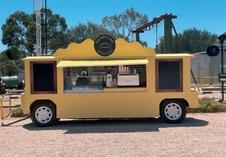
PUBLISHER
National Trust of South Australia
Beaumont House 631 Glynburn Road Beaumont SA 5066
T: 08 8202 9200
E: publications@nationaltrustsa.org.au W: www.nationaltrust.org.au/sa
DESIGN
Dessein T: 08 9228 0661
E: tracy@dessein.com.au
Heritage Living is published four times a year.
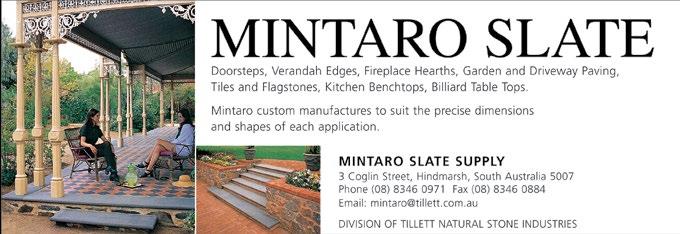
PP 536155/0036 ISSN 0815-7871
FRONT COVER:
PRESIDENT
Mr Paul Leadbeter
VICE PRESIDENT
Ms Millie Nicholls
COUNCILLORS
Professor Brett Bowden
Mr Tully Brookes
Ms Elaine Davies
Ms Alice Fitch
Mr James Harvey Ms Gabrielle Iwanow Mrs Caren Martin
Ms Alison Stillwell OAM
Ms Di Wilkins
NTSA STATE OFFICE TEAM
Dr Darren Peacock Chief Executive Officer
Leanne Plews Executive Administrator
Alison De Backer Project Consultant
Catherine Gawrysiuk
Membership Coordinator and Finance Officer
Charlie Gilchrist Communications Officer
Chris Grant Natural Heritage Manager
James Guy Regeneration Projects Officer
Christina Roberton Administration Officer
Photo: Hughes Engine House, and chimney, Moonta Mines.

Credit: Alex Frayne.
Bridgette Walmesley-Cotham Silver to Sea Way project
Joanna Wells Advocacy Coordinator
Audit, Finance and Governance Cultural Heritage Advisory Natural Heritage Advisory
NTSA LOCAL BRANCHES (44)
Ardrossan, Burnside, Coromandel Valley, Gawler, Port of Adelaide, Tea Tree Gully, Ceduna, Cleve, Koppio, Streaky Bay, Tumby Bay, Whyalla, Auburn, Burra, Clare, Jamestown, Port Pirie, Barmera, Overland Corner, Renmark, Waikerie, Beachport, Glencoe, Keith, Kingston SE, Millicent, Mount Gambier, Naracoorte, Penola, Robe, Goolwa, Hahndorf, Kingscote KI, Mount Barker, Penneshaw, Port Elliot, Strathalbyn, Victor Harbor, Willunga, Central Yorke Peninsula, Kadina, Minlaton, Moonta, Wallaroo.
Telephone (08) 8202 9200 or visit nationaltrust.org.au/sa for contact information.
PATRON IN CHIEF
Her Excellency the Honourable Frances Adamson AC Governor of South Australia
The National Trust of South Australia acknowledges its partners and supporters.
CIVIC PARTNERS
Adelaide City Council
CORPORATE PARTNERS
Beerenberg Farm Bickfords
Coopers
Laucke Flour Mills
Piper Alderman Stoneideas Wines by Geoff Hardy
Australian Government – Department of the Environment and Energy
– National Library of Australia
South Australian Government – Department of the Environment and Water
– SA Water – History Trust of South Australia




